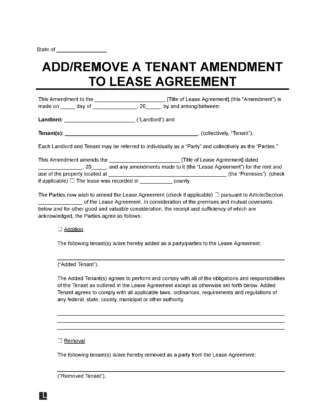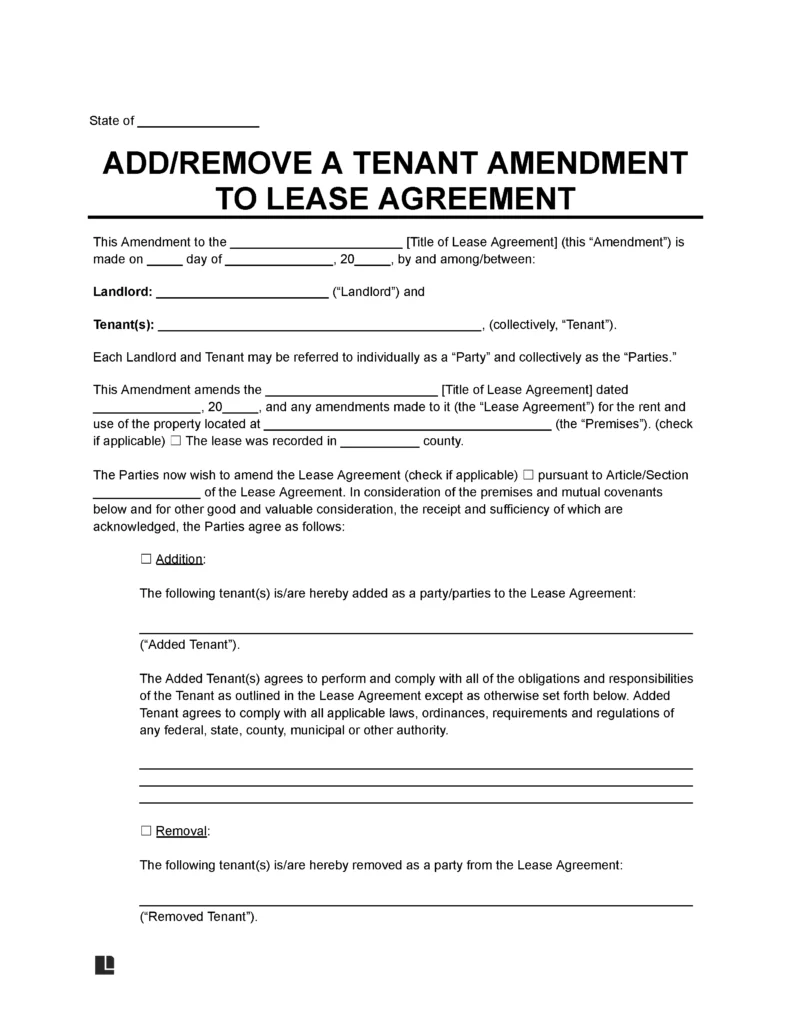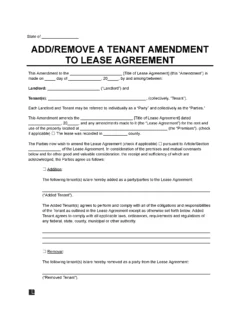
Use a Add/Remove a Tenant Lease Amendment to adapt a lease’s terms to the inclusion or exclusion of a tenant.

Updated May 20, 2024
Written by Yassin Qanbar | Reviewed by Susan Chai, Esq.
An add/remove tenant lease amendment is a document permitting the inclusion or exclusion of a tenant from an existing lease agreement. This type of amendment is typical among roommates or tenants in romantic partnerships.
Following a breakup, the departing individual frequently asks the landlord to be released from the lease. Conversely, when a new occupant moves in, landlords often require that this individual be officially added to the lease.
Tenants’ situations can change after signing their lease, prompting the need to modify their rental agreement. Common reasons include:
Landlords should actively manage their properties to prevent unauthorized occupancy:
Adding or removing a tenant involves a clear process to ensure all legal and practical aspects are covered. Here’s a streamlined guide to manage this process effectively:
Request a written application from your current tenant if they want to add another person, like a partner or roommate. This formal request helps avoid hasty decisions and provides clarity on what is being asked.
Verify that adding another person won’t exceed the property’s legal occupancy limits, which typically allow two people per bedroom plus one.
Have the potential new tenant fill out a rental application to conduct background and reference checks. Ensure they meet the standard leasing qualifications without exception.
Based on the tenant checks’ findings, decide whether to approve or deny the application. Communicate your decision in writing to both the current and prospective tenant, explaining any denials clearly.
If approved, discuss the new lease terms, including any additional security deposit required. Have all parties sign the updated lease or amendment and distribute copies.
First, review the terms of your existing lease to understand the conditions under which a tenant can be removed, whether by mutual agreement or for breach of contract.
Discuss the situation with the tenant to see if they are willing to voluntarily leave the lease. If the tenant agrees, this can be the simplest solution.
If the tenant does not agree to leave, you may need to issue a formal notice of eviction based on the grounds specified in your lease or local laws (e.g., non-payment of rent, violation of lease terms).
Should the tenant refuse to vacate after a formal notice, the next step is to file for eviction with the local court. Ensure you follow all legal procedures to avoid potential legal repercussions.
Once the eviction is approved or the tenant agrees to leave, make sure to update your lease documents and check the property for any damage or issues that need addressing before re-renting.
A landlord can deny adding or removing a tenant based on legitimate grounds such as capacity limits, financial stability, or lease violations. However, decisions must comply with The Fair Housing Act, ensuring no discrimination based on race, color, religion, sex, national origin, disability, or familial status.
When drafting, include:
Additional considerations:
In certain situations, drafting a new lease agreement might be more appropriate than adding an addendum. This approach is often favored when substantial changes are needed, such as when adding a new tenant or starting a new lease term.


Create Your Add/Remove a Tenant Lease Amendment in Minutes!